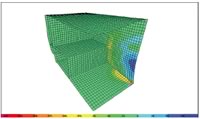Isotropic Modeling of a Composite Panel of the Stern of a Fiberglass Boat Propelled by an Outboard Motor
DOI:
https://doi.org/10.25043/19098642.90Keywords:
Sandwich, module, finite, composite resinAbstract
We performed a theoretical and experimental study to define the best way to model the finite element sandwich structure aft of a fiberglass boat less than 15 meters in length, using an isotropic linear mathematical model that fits anisotropic material conditions. This is done by defining the properties of the ship’s fiberglass resin structure, which is representative of the influence of the forces acting during the glide on the geometry of the entire vessel. Formulation of the Finite Elements Method is presented, which works on the mathematical model to define the limitations of the results obtained. Isotropic material adjustment is calculated using Halpin-Tsai laws, developing its mathematical formulation for restrictions of modulus data entered as the finite element program experimentally calculated for each of the sandwich materials. The best-fit mathematical presentation to the modulus of the composite tool justifies the calculation thereof.
Downloads
References
A. MIRAVETE, “Materiales Compuestos I”. Editorial Reverté, Barcelona España, 2007.
A. HORTA, “Macromoléculas”. Librería UNED, Tercera Edición. 2002.
ALEJANDRO BESEDNJAK, “Materiales Compuestos: procesos de fabricación de embarcaciones”. Books. Google.com. 1995.
ASTM, “Standard Test Method for Tensile properties of polymer Matrix Composite Materials”. American Society for Testing and Material. USA, 2002.
B. MAC DONALD, “Practical Stress Analysis with Finite Elements”. Page 215. Dublin, Ireland. 2007.
C. MARISCAL, “Formulación y Evaluación de Proyectos”. Escuela Superior Politécnica del Litoral, ESPOL, 109 páginas. Guayaquil, Ecuador. 2001.
C. KASSAPOGLOU, “Desing and Analysis of Composite Structures”. First Edition, The Atrium & Southern Gate. London, UK. 2010.
D. CHUNG, “University Notes: Science and Applications: Composite Material”. Second Edition, British Library Cataloguing in Publication Data. State University of New York, Buffalo, USA. 2010.
D. FELDMAN, A. BARBALAT, “Synthetic polymers: technology, properties, applications”. London, United Kingdom.1996.
E. CAR, S. OLLER, E. OÑATE, “Tratamiento numérico de los materiales compuestos”. Centro Internacional de Métodos Numérico de Ingeniería. Madrid, España. 2000.
F. BILLMAYER, “Science of Polymers”. New York, USA 1975.
F. SINGER, A. PYTEL, “Resistencia de Materiales”. Impreso en México Tercera edición, 560 páginas. D.F. México. 1982.
G. GILI, “Arquitectura Naval: Teoría del buque y sus aplicaciones”. 574 páginas. España 1956.

Published
How to Cite
Issue
Section
License
The authors who publish in this Journal certify that:
- The work submitted for publication in The Ship Science and Technology journal, was written by the author, given that its content is the product of his/her direct intellectual contribution.
- All data and references to material already published are duly identified with their respective credits and are included in the bibliographic notes and quotations highlighted as such.
- All materials submitted for publication are completely free of copyrights; consequently, the author accepts responsibility for any lawsuit or claim related with Intellectual Property Rights thereof, Exonerating of responsibility to The Science and Technology for the Development of Naval, Maritime, and Riverine Industry Corporation, COTECMAR.
- In the event that the article is chosen for publication by The Ship Science and Technology journal, the author state that he/she totally transfers reproduction rights of such to The Science and Technology for the Development of Naval, Maritime, and Riverine Industry Corporation, COTECMAR.
- The authors retain the copyright and transfer to COTECMAR the right of publication and reproduction of the work which will be simultaneously subject to the Creative Commons Attribution License (CC -BY) , which allows the license to copy, distribute, display and represent the work and to make derivative works as long as it recognizes and cites the work in the manner specified by the author or licensor.
- For more information about the Creative Commons Attribution License (CC -BY) and his use and scope, please visit the following web page https://creativecommons.org/licenses/by-sa/4.0/legalcode








